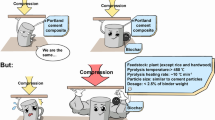Abstract
For every ton of portland cement that is manufactured, approximately half a ton of carbon dioxide is released from calcining limestone. One method of reducing the carbon dioxide from portland cement production is to reduce or eliminate the use of limestone through replacement with calcium oxide-bearing waste materials. In this study, portland cement clinker was synthesized using minimal limestone content and maximal waste material content, specifically fly ash and blast furnace slag. The synthetic cements were characterized using X-ray diffraction, scanning electron microscopy, and isothermal calorimetry. Results show that portland cement clinker can be successfully synthesized from a maximam of 27.5% fly ash and 35% slag. The synthetic cements possessed early-age hydration behavior similar to a commercial Type I/II portland cement. However, the presence of sulfur impurities contained in waste materials significantly affected phase formation in portland cement clinker.











Similar content being viewed by others
Notes
In cement chemistry notation, oxides are abbreviated by the first capital letter: C = CaO, S = SiO2, A = Al2O3, F = Fe2O3, H = H2O, and $ = SO3.
References
Mindess S, Young JF, Darwin D (2003) Concrete, 2nd edn. Pearson Education, Inc, Upper Saddle River, NJ
Hendricks CA, Worrell E, Price L, Martin N, Ozawa Meida L, de Jager D, Riemer P (1998) Emission reduction of greenhouse gases from the cement industry. Proceedings of the 4th international conference on greenhouse gas control technologies, Interlaken, Austria, IEA GHG R&D Programme, UK
Romano JS, Rodrigues FA, Bernardi LT, Rodrigues JA, Segre N (2006) J Mater Sci 41:1775. doi:https://doi.org/10.1007/s10853-006-2922-2
Singh M, Garg M (2000) Cem Concr Res 30:571
Singh M, Upadhayay SN, Prasad PM (1996) Waste Manage 16:665
Shih PH, Chang JE, Chiang LC (2003) Cem Concr Res 33:1831
Komljenovic M, Jovanovic N, Petrasinovic-Stojkanovic LJ, Bascarevic Z, Rosic A (2007) Fly ash as an alternative raw materials for portland cement clinker synthesis. Proceedings of the 12th international congress on the chemistry of cement, Montreal, Canada
Monshi A, Asgarani MK (1999) Cem Concr Res 29:1373
ASTM C 618 (2005) Standard specification for coal fly ash and raw or calcined natural pozzolan for use in concrete. American society of testing and materials, West Conshohocken, Pennsylvania
Fierens P, Trilocq J (1983) Cem Concr Res 13:267
Bogue RH (1929) Ind Eng Chem Res 1:192
Taylor HFW (1997) Cement chemistry, 2nd edn. Thomas Telford, London
ASTM C 150 (2005) Standard specification for portland cement. American society of testing and materials, West Conshohocken, Pennsylvania
Richerson DW (1992) Modern ceramic engineering: properties, processing, and use in design, 2nd edn. Marcel Dekker, Inc, New York
Fierens P, Trilocq J (1983) Cem Concr Res 13:41
Mohamed BM, Sharp JH (2002) Thermochimica Acta 388:105
Stephan D, Whilhelm P (2004) J Inorg Gen Chem 630:1477
JCPDS, International Centre for Diffraction Data (1989) Powder diffraction file search manual (Hanawalt method): Inorganic
Stutzman PE, Leigh S (2002) NIST Tech Note 1441:44
Young RA (1995) In: Young RA (ed) IUCr monographs of crystallography: the Rietveld method, vol 5. Oxford University Press, New York
Whitfield PS, Mitchell LD (2003) J Mater Sci 38:4415. doi: https://doi.org/10.1023/A:1026363906432
Stutzman P (2004) Cem Concr Compos 26:957
Abramoff MD, Magelhaes PJ, Ram SJ (2004) Biophotonics Int 11:36
Rasband WS (1997–2007) ImageJ. US National Institutes of Health, Bethesda, Maryland, USA. https://doi.org/rsb.info.nih.gov/ij/
Lydon JW (2005) The measurement of the modal mineralogy of rocks from SEM imagery: the use of Multispec© and ImageJ freeware. Geological Survey of Canada, Open File 4941:37
Gartner EM, Young JF, Damidot DA, Jawed I (2002) In: Bensted J, Barnes P (eds) Structure and performance of cements. Spon Press, New York
Odler I (1998) In: Hewlett PC (ed) Lea’s chemistry of cement and concrete. Arnold, London
ASTM C 204 (2007) Standard test methods for fineness of hydraulic cement by air-permeability apparatus. American society of testing and materials, West Conshohocken, Pennsylvania
Uda S, Asakura E, Nagashima M (1998) J Am Ceram Soc 81:725
Chen IA, Juenger MCG (in press) Int J Appl Ceram Technol. doi:https://doi.org/10.1111/j.1744-7402.2008.02267.x
ASTM C 1365 (2006) Standard test method for determination of the proportion of phases in portland cement and portland-cement clinker using X-ray powder diffraction analysis. American society of testing and materials, West Conshohocken, Pennsylvania
Lerch CW (1947) Proc Am Soc Test Mater 46:1252
Bentz DP, Garboczi EJ, Haecker CJ, Jensen OM (1999) Cem Concr Res 29:1663
Acknowledgement
The authors express their thanks to the National Science Foundation for financial support (Grant No. CMMI 0448983), Texas Lehigh Cement Company for providing natural raw materials, Mr. Paul Stutzman from NIST for providing the phase lattice files used in Rietveld analysis, Ryan Chancey, a graduate student in our lab, for assistance with the Rietveld and multispectral image analysis, and Katherine McKeever, a former graduate student in our lab, for establishing the synthesis procedures for the four major cement phases.
Author information
Authors and Affiliations
Corresponding author
Rights and permissions
About this article
Cite this article
Chen, I.A., Juenger, M.C.G. Incorporation of waste materials into portland cement clinker synthesized from natural raw materials. J Mater Sci 44, 2617–2627 (2009). https://doi.org/10.1007/s10853-009-3342-x
Received:
Accepted:
Published:
Issue Date:
DOI: https://doi.org/10.1007/s10853-009-3342-x




